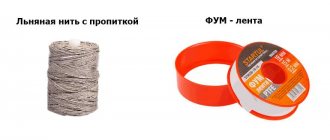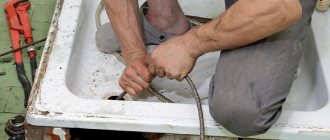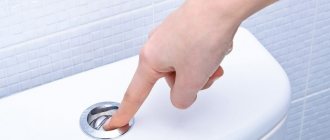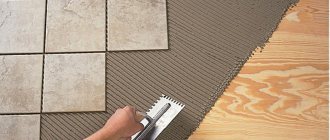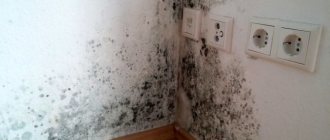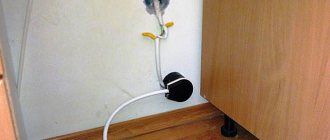A lovingly made renovation in the kitchen, carefully selected interior decor elements, beautiful dishes - in the morning you usually don’t want to leave your cozy nest. So you went out into the kitchen in the morning, prepared to make yourself a cup of coffee and some... What is that unpleasant smell coming from the sink? Let's let the water through - that's right, the water doesn't go away! Instead of morning bliss, we have a clog in the kitchen sink, what should we do, call a plumber or try to deal with it ourselves? The answers are in our article.
First, let us reassure you that most blockages can be eliminated on your own , without calling specialists. There are several methods; if in your case one of the selected options does not turn out to be effective enough, you can use another. Also, at the end of our article, we’ll talk about preventing clogs in the kitchen sink.
Who is to blame and what to do?
Two eternal Russian philosophical questions are quite applicable to our situation. First , check whether there is a special mesh on the sink drain that does not allow food debris, large fractions of vegetable peels, hair and pet hair to freely penetrate into the sewer pipe and form such a delicious plug there, mixing with fat.
If there is no mesh , only you are to blame, how to remove the blockage - urgently go to the hardware store for a miracle mesh.
But there may well be a situation where the fat washed off from the dishes remains on the walls of the sewerage elements and catches the smallest food debris and so on. A clog forms, just not so quickly, not once a week, but once a year , and then one day, not a wonderful day, the water stands in the sink, and the plastic mesh, on which so much hope is placed, drifts on the surface of the water.
What should I do? Let's roll up our sleeves and get down to business.
But the owners are not always to blame; let’s list all the causes of blockages:
- the fine litter already mentioned above (food remains, fat, threads, hair);
- corrosion of pipes (typical of old housing stock);
- defects in the operation of the sewer system (improper installation of the siphon, depressurization of the pipeline, etc.).
In our article we will analyze options for action for the first, most common reason. If old pipes are corroded, they become brittle - in this case, they should be replaced with more modern building materials (in a plastic pipe, for example, there will be no such deposits).
If there are defects in the sewer system, specialists should be invited to diagnose and fix the problem.
Causes of clogging
Before you start cleaning, you need to familiarize yourself with the main causes of blockages. These include the following:
- Mechanical. Most often, the sink becomes clogged due to mechanical blockages, during which foreign objects and debris get into the pipes. Gradually, the amount of debris accumulates, and water begins to flow worse through the pipes.
- Operational. Operational reasons include the accumulation of fat inside the pipes or the appearance of corrosion.
- Incorrect installation. Sometimes the kitchen is equipped with pipes that are installed incorrectly. Problems can arise if they are installed at the wrong angle, causing debris to gradually accumulate inside.
Basic cleaning methods
There are four reliable ways to clear a clogged sink:
- mechanical;
- chemical;
- hydrodynamic;
- using home remedies.
Below we will analyze in detail each of the popular options. The hydrodynamic method is the least popular, since hydrodynamic sewer cleaning is carried out with special devices; it is an effective cleaning method, but the devices themselves are not very common.
To begin with, you can run a sufficient amount of hot water, the fat will dissolve, if the plug is small, it will break up and go through the pipes. In the future, it will only be necessary to carry out preventive measures to avoid clogging; we will discuss them below.
If hot water does not clear the blockage, then the problem is more serious; we will solve it in other ways.
Removing a clog in the kitchen sink
Solution
For convenience, it is advisable to disconnect the corrugation from the drain pipe. You can once again make sure that a certain amount of water has actually accumulated there. Now a simple trick is done that solves the issue of draining water in seconds. The corrugation should simply be straightened. When straightening it, it is necessary to reduce it in size so that it does not sag. It is then inserted back into the drain pipe and positioned so that the water can flow out directly. It should look like the photo below.
When all the manipulations are done, you can make sure that the water completely leaves the sink.
Found a violation? Report content
Mechanical cleaning of sewer pipes
At home, you can mechanically clean pipes with a plunger or plumbing cable.
The plunger is a time-tested invention, inexpensive, and lasts a long time. You should buy a separate plunger for the kitchen; for hygiene reasons, you should not use the same one as in the bathroom.
The most reliable plunger is a wooden handle and a rubber pump base; plastic options are not so reliable. How to use it? We install it exactly above the sink drain, make sure that the rubber fits tightly to the bottom of the sink, and let the water flow. Let's take in enough water so that the rubber part of the plunger is under water, press vigorously with all our hearts a dozen times. If the blockage is small, the water will whistle down the drain. It is done!
What to do if your kitchen sink has two sections? Ideally, you should have a pair of plungers and work with them at the same time - this will provide you with excellent cleaning of the sewer system. If you don't have a second kitchen plunger, simply cover the other drain hole with your hand or a rag.
How to clear a clog without a plunger? If you don’t have it on your household, you can imitate its work with a glass, a hand in a rubber glove, or a rag. The principle of operation is the same: close the drain hole, fill with water, and sharply pull up.
Cleaning with a plumbing cable is not as simple as working with a plunger. But you can cope with it too! The cable is purchased at the store and must be used carefully.
The siphon is removed, the end of the cable is inserted there, with rotational movements of the handle the cable is pushed inside the sewer pipe and either crushes the resulting plug, or you take this mass out and throw it away. After installing the siphon in place, run hot water thoroughly. Enjoy the purity and freshness you deserve.
When working with plumbing cable, observe the following rules. The cable must be in good condition, without damage, the handle must be securely fastened to it.
You should rotate strictly in one direction at a measured speed; moving the handle randomly can damage the pipe. If suddenly the end of the cable gets stuck in the sewer, only in this case should you very carefully and slowly turn the handle in different directions until the obstacle is passed.
It is more convenient to carry out this procedure with two people - one regularly rotates the handle, the other controls the cable.
In modern apartments, the entire sewage system is interconnected. Before you start working in the kitchen, take a minute - go to the bathroom, plug the drain hole of the bathtub and sink, then go to the toilet and lower the toilet lid. These simple steps, which won’t take up your time and energy, will help you clean your kitchen sink more effectively.
You can also disassemble the drainage elements under the sink and manually clean each part. Only do this job if you are confident that you can handle it.
Siphon disassembly
The siphon under sinks is a dismountable device that can be cleaned by simply disconnecting it from the system. Despite the features of the models, the principle of organization of the devices is very similar. For the most part, cleaning is not difficult and can easily be done on your own, without the involvement of a plumber.
No complex tools or special skills are required for cleaning. The parts under the sink in plastic systems are fixed with plastic fasteners, which can be unscrewed simply by hand.
It must be taken into account that there is dirty water in the siphon. To prevent it from splashing, you should place a bucket or basin under the sink in advance.
When unwinding the siphon elements, it is necessary to monitor the condition of the gaskets. When they wear out, replacement will be required.
Clearing a clogged kitchen sink is shown step by step in the video:
Chemistry comes to the rescue
The choice of chemicals for cleaning sewer pipes is extensive - in any hardware department you will find something that you can afford.
The assortment is large - gels, granules, powders. In such chemical compositions, the active substance is either an alkali or an acid. Whatever you choose, the first thing you should take care of is your own safety.
Aggressive chemistry will not improve your health if you accidentally drop it onto your palm, so let's talk about precautions.
We open the windows, put on a protective mask and goggles, and wear thick rubber gloves on our hands. If the windows of your house face different sides and it is possible to provide cross ventilation, do it.
Never use two different cleaning chemicals at the same time, even with the best intentions - compounds can form that will harm not only the sewer system, but also you.
If you are a resident of an old housing stock with cast iron pipes, this method is not suitable for you. If you have plastic pipes, you should not increase the contact time of chemicals and elements of the sewer system prescribed by the manufacturer. By the way, the label should say that it is intended for your type of pipe.
If the blockage problem has been acute for quite a long time, perhaps one chemical filling will not be enough for you. Therefore, wait the allotted time (read the label), spill hot water and use the services of a trouble-free plunger. Together, both methods will definitely help you!
What if there are children and animals in the house? And you don’t want to use aggressive chemicals? Isn't there a more gentle way? There are such recipes, and we will definitely tell you about them.
Video description
The effect of “Bagi Pothan” against plaque and pollution is clearly shown in this video clip:
"Mole" for blockages
"Mole" is a universal product for cleaning pipes. It contains potassium, sodium and acetic acid. This tandem removes heavy dirt and plaque. A significant advantage of the product is its low cost and effectiveness. In addition, it does not have an unpleasant odor and does not cause allergic reactions.
One application of "Mole" is enough for several months. To clean, pour a few spoons of the powdered product into the drain and leave it for 1 hour. After this, pour 1.5 liters of just boiled water into the pipe.
Baking soda, vinegar and lemon are useful for more than just lemon pie
Those who don’t like radical chemicals can always turn to homemade sink cleaning recipes. You can break through a cork using various substances that any housewife can find.
There is an opinion that keeping your apartment clean can be done by having a sponge, baking soda, lemon (citric acid) and vinegar on hand.
Mirrors and windows are rinsed with a vinegar solution; it has dust-repellent properties and does not leave streaks. Citric acid removes scale from teapots one-two-three times. Use baking soda to make your kitchenware shine. The list goes on for a long time. But let's turn to our problem - there is a blockage in the sink.
To remove a garbage plug, try any of the effective recipes below.
Soda and vinegar
Take 200 g of soda, pour it into the sink drain, add 250 ml of 9% vinegar, close the hole tightly. A rather caustic foam is formed, which will cope with the problem.
After half an hour, turn on the hot water, skip a few minutes to achieve perfect cleanliness of all elements of the sewer system. Cleaning should be done with the windows open.
Lemon acid
Take 100 g of citric acid, pour it into the sink drain, add a glass of boiling water, and close with a stopper. After half an hour, run hot water for a few minutes.
Alka-Seltzer
An original way to clean the sink siphon is to use a home first aid kit. Alka-Seltzer is perfect for solving our problem. Place 2-3 tablets in the drain, pour in 250 ml of 9% vinegar, close the drain hole. After a few minutes, run hot water.
In conclusion, let's talk about preventing a clogged kitchen sink, because many problems will not become so if we do not allow it ourselves.
Why does the water in the sink drain slowly?
Water may begin to flow poorly in the sink due to several reasons, the main of which will be a clog. Pieces of food, residual fat, hair, and detergents accumulate in the siphon. Because of this, the diameter of the pipe becomes smaller and the liquid begins to flow poorly.
A blockage may also appear due to a small object getting into the pipe, for example, a toy, a lid from a jar, a paper clip, a piece of paper, and so on. In this case, the plug that prevents water from passing may not be in the siphon, but in some part of the pipe. Therefore, you can’t do without a plunger and a special cable.
REFERENCE! It is better to prevent blockages than to get rid of them. To do this, you need to regularly rinse the sink with boiling water, in a volume of about 2-3 liters. It is better to do this after each dishwashing or at least once a day.
You should also know that boiling water should only be poured into metal sinks; earthenware ones can burst if the water is too hot. In addition, you should be sure to use protective nets that will prevent particles of debris and food from entering the pipes.
Plumbing cable
The previous method is only suitable if the blockage is minor; it cannot cope with serious blockages. An option is a plumbing cable. It is suitable if:
- The blockage is deep in the pipe.
- The “plug” that closes the outflow of water is heavily compressed.
Plumbing cable is a dense wire in the shape of a spiral.
The essence of the method is to get rid of the blockage mechanically, pull it out or push it deeper into a wider pipe. The length of the standard cable is 3 meters, and this is quite enough to remove deep blockages.
The technique of using a cable is not complicated, but it must be strictly followed. Subsequence:
- the cable is inserted into the drain hole;
- one person pushes, the other rotates the cable. This helps break up the blockage and prevents the cable from breaking at the bends of the pipe;
- After the blockage has been cleared, you need to make a couple of jerks back and forth. After opening the hot water, you will wash away the dirt that has formed on the pipe;
- Now you can carefully pull out the cable.
This cleaning device can be purchased at any hardware store.
This device is used for severe blockages of metal pipes.
Note! It cannot be used for plastic and chrome-plated pipes; the cable design may damage their inner surface.
Where is the blockage?
Cleaning sewer pipes is greatly facilitated and less dirt comes out if the means and methods for it are chosen in accordance with the expected location of the blockage:
- A fat plug can occur anywhere; most often in the kitchen. If the owners decided to save on a siphon for washing and made a water seal for it by bending the standard drain corrugation in a U-shape, the regular appearance of grease plugs in it is guaranteed. Also - in the deck under the sink outlet, if the pipe slope is less than 2 cm/m or more than 5 cm/m. Also at pipe joints, if the sewerage and sealing are done incorrectly, see below. A plug from kitchen scraps can usually be easily broken through with a plunger or removed with chemicals, see below. To push through a plug caused by other contaminants, you most often have to use a cable, because... In this case, you need to pour so much aggressive chemical into the pipe that it will damage the pipe and/or cause leaks at the joints.
- Hair collects in the bathtub siphon; it must be removed from there when the first signs of blockage appear with the snake cable, see below.
- Lint accumulates from the water seal of the washing machine, or, if there is no separate drain from it, from the bathtub or washbasin sink. A radical way to eliminate lint blockage, as well as to avoid its further consequences, is to place a bucket under the siphon, unscrew the standard cleaning hatch on it and remove the contamination with a snake.
- The fecal blockage is localized in the water seal of the toilet, the drain tee, or the section of the riser nearby below. If the toilet is made of earthenware, and the fan crosspiece and riser are cast iron, you can unclog the toilet without the risk of turning into something like its contents, using modern means of chemical sewer cleaning. Otherwise (any plastic) you will have to use a cable in a plastic sheath with a plastic brush or a homemade gentle cable (see below).
- Small hard objects (coins, brooches, earrings, etc.) can settle anywhere. In this case, it is often possible to break through the blockage and even remove the object using a cable with a regular spiral nozzle. Large objects most often have to be pushed until the bed exits into the riser or cesspool (septic tank) using a cable with an attachment: a smooth sliding knife (in plastic pipes) or a shark tooth knife (in cast iron)
How to remove grease
It is necessary to completely clear the blockage in the sink, completing it with chemicals and washing.
Cleaning the sewer system from grease contaminants begins with the devices furthest from the riser. If there is a double sink in the kitchen, the sink that is furthest from the common drain into the bed is cleaned first; The nearby drain is reliably plugged with a plug or improvised means (rag, etc.). You also need to plug the drain and overflow of the bathtub.
If the washing machine drain is stationary, its hose must be disconnected from the additional siphon pipe, and the pipe must be securely plugged, or the hose must be bent in half and tied tightly (but not squeezing!). In general, the best way to prevent waste from getting into the washing machine when clogged is to equip it with a separate drain through a jib 700-850 mm high and a water seal. It’s even safer, but more troublesome, to drain the washing machine into the bathtub or sink.
During the cleaning process, the first step is to open the siphon hatches, starting from the kitchen, and their contents are released or emptied into a bucket. Next, the hatches are closed and chemicals are applied in the same order, according to the instructions for the product or according to the description for the homemade one. After this, the system is washed with hot (50-60 degrees) water at the rate of a bucket for each meter of pipe length, including drains from appliances.

